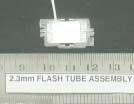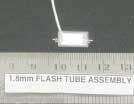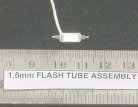The importance and popularity of a technological product is reflected in the amount of R&D going into it. Cell phones that contain a camera have become must-haves for millions, and their increasing popularity has spurred improvements in digital-imaging sensors, the development of a fluid-based autofocusing mobile-phone-camera lens by Varioptic (Lyon, France; see Laser Focus World, November 2003, p. 17), and the placement of light-emitting-diode (LED) flash units in cell phones.
But, in the case of cell-phone flashes, solid-state technology may not have the upper hand. Engineers at PerkinElmer Optoelectronics (Fremont, CA) are going one better than the LED flash by miniaturizing a more-traditional light source-the xenon flashlamp-for the same purpose. The resulting lamp, which is only 1.6 mm wide and has been embedded in a mobile phone produced by Kyocera (Yokohama, Japan), can project to four times the distance of an LED flash. The three PerkinElmer flashlamps shown illustrate the miniaturization of the technology.
Miniaturization of the lamp was not entirely straightforward: not only does the available gas volume shrink, but so does the size of the lamp’s capacitor-both potentially reducing the energy of the flash, says technology product manager Rick Yeo. While the engineers had to live with reduced output from the capacitor, they increased lamp pressure to retain a comparable mass of xenon in the lamp. But the higher density also increased the lamp’s “triggerability,” which required raising the trigger voltage. In general, careful attention had to be paid to the raw materials that went into the lamp, monitoring their purity, modulus, optical, and other properties.
The flashlamp uses less power than an LED cell-phone flash and emits for a shorter duration, allowing cell-phone photographers to capture fast-moving objects. The miniature xenon lamp has a “guide number” of 1.5, five times higher than an LED cell-phone flashlamp (the guide number is a traditional flashlamp measure useful for photographers, who derive lens settings from it). And, while white-light-emitting LEDs are gradually improving in the color balance of their output, it will be difficult for them to match the even, sunlike spectral output of xenon lamps.


